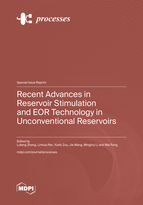Recent Advances in Reservoir Stimulation and EOR Technology in Unconventional Reservoirs
A special issue of Processes (ISSN 2227-9717). This special issue belongs to the section "Energy Systems".
Deadline for manuscript submissions: closed (15 July 2023) | Viewed by 43963
Special Issue Editors
Interests: hydraulic fracturing; acidizing; numerical simulation
Special Issues, Collections and Topics in MDPI journals
Interests: rock mechanics; reservoir stimulation
Interests: rock mechanics; hydraulic fracturing;
Interests: enhanced oil recovery; reservoir stimulation; natural gas hydrate
Special Issues, Collections and Topics in MDPI journals
Interests: hydraulic fracturing; fracture propagation; temporary plugging and diverting fracturing; numerical simulation
Special Issue Information
Dear Colleagues,
In the past decade, the rapid increase in the production of fossil energy has been made possible by effective reservoir stimulation and enhanced oil recovery (EOR) technologies for unconventional oil and gas reservoirs. As one of the most important reservoir stimulation technologies, hydraulic fracturing usually injects high-pressure fluid to create enough fractures in the target reservoir, which aims to improve the seepage conditions and increase the contact area between the target formation and production well. Such stimulation technologies usually involve complex fluid–solid coupling processes, including fracture initiation, fracture propagation, fracture conductivity, etc. Enhanced oil recovery has been used to solve the problem of rapidly declining oil rate sharply after a period of production. In this process, some special chemicals (e.g., surfactants and nano-emulsions) are injected into the reservoir to increase the recovery effectiveness of the residual oil. EOR processes often involve complex physical-chemical processes, including liquid emulsification, water–rock reactions, etc. Therefore, the progress of reservoir stimulation and EOR technology will contribute to the rapid development of unconventional oil and gas resources. Meanwhile, these technologies are also used in the development of geothermal and coal resources.
This Special Issue on “Recent Advances in Reservoir Stimulation and EOR Technology in Unconventional Reservoirs” will collect research articles and comprehensive reviews focused on the aforementioned topics.
Topics include, but are not limited to:
- Rock mechanics problems associated with reservoir stimulation, including rock properties changes at high temperatures and pressures or acid–rock reaction conditions, rock microfracture generation during hydraulic fracturing, stress field changes after hydraulic fracturing, water–rock reaction, acid–rock reaction.
- New research on hydraulic fracture initiation pressure or geometry, including fracture initiation and propagation during hydraulic fracturing, fracture initiation pressure or initiation effectiveness in the horizontal wellbore, stress shadow between multiple fractures, and fracture re-orientation when re-fracturing.
- New methods to improve the stimulation effectiveness, including CO2 fracturing, temporary plugging and diverting fracturing, liquid nitrogen fracturing, etc.
- New highly effective EOR technology, including supercritical CO2 flooding, surfactant flooding, nanofluids, nanoemulsions, spontaneous absorption, etc.
- New applications using reservoir stimulation technology and EOR technology, including the development of dry heat rock resources or geothermal, coal bed methane, and hydrates.
Dr. Lufeng Zhang
Prof. Dr. Linhua Pan
Dr. Yushi Zou
Dr. Jie Wang
Dr. Minghui Li
Dr. Wei Feng
Guest Editors
Manuscript Submission Information
Manuscripts should be submitted online at www.mdpi.com by registering and logging in to this website. Once you are registered, click here to go to the submission form. Manuscripts can be submitted until the deadline. All submissions that pass pre-check are peer-reviewed. Accepted papers will be published continuously in the journal (as soon as accepted) and will be listed together on the special issue website. Research articles, review articles as well as short communications are invited. For planned papers, a title and short abstract (about 100 words) can be sent to the Editorial Office for announcement on this website.
Submitted manuscripts should not have been published previously, nor be under consideration for publication elsewhere (except conference proceedings papers). All manuscripts are thoroughly refereed through a single-blind peer-review process. A guide for authors and other relevant information for submission of manuscripts is available on the Instructions for Authors page. Processes is an international peer-reviewed open access monthly journal published by MDPI.
Please visit the Instructions for Authors page before submitting a manuscript. The Article Processing Charge (APC) for publication in this open access journal is 2400 CHF (Swiss Francs). Submitted papers should be well formatted and use good English. Authors may use MDPI's English editing service prior to publication or during author revisions.
Keywords
- reservoir stimulation
- hydraulic fracturing
- fracture initiation
- fracture propagation
- unconventional reservoirs
- EOR technology
- CO2 fracturing
- acid fracturing
- geothermal
- hydrates











